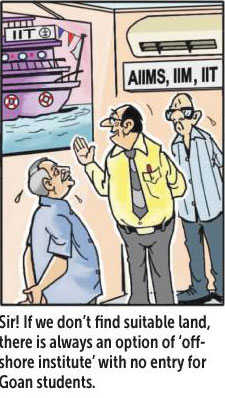
Team Herald
PANJIM: The Goa bench of the Bombay High Court on Friday reiterated that whoever is behind the cutting of age-old trees in Siolim has to be found out. The court observed that there was a possibility that it was done for someone’s benefit.
Advocate General Devidas Pangam however, denied that tree cutting was done for someone’s benefit. He told the Court that there may have been a violation and somebody took law into their hands and hence illegal, due to which it was a matter of investigation.
“Investigation might be an eyewash,” a division bench of Justice M S Karnik and Justice Valmiki Menezes said, adding that, if need be, they will enlarge the scope of the case.
The division bench observed that prima facie the owners will be responsible and since none of the owners barring one had filed a complaint. So it looks like there was a lot of fear there.
When asked about the status of the investigation conducted by the Range Forest Officer (RFO), it was submitted that the investigation had concluded and the report was filed on Thursday. The Court later asked the government to furnish the same before the next hearing fixed on July 2.
Appearing for the petitioners, advocate Norma Alvares, stressed that the penalty prescribed under the Goa Tree Preservation Act, which is one year of imprisonment or a fine of Rs 1 lakh should be imposed on whoever was responsible for the butchering of the trees at Siolim.
Justice Valmiki Menezes pointed out that everybody will be emboldened and people will be waiting to replicate all this if no action is taken.
The State government submitted that there was no other option but to widen the roads but the judges expressed their distress over the fact that 100-year-old trees had been cut.
The question is who benefits? Widening roads would be better for businesses and trade. They should benefit, but not like this, the court said.
Advocate Norma submitted that new trees should be planted in the same place and people, who illegally felled them should be taught a lesson.
Adv Alvares further brought to notice the High Court of Bombay at Goa judgement in a petition filed by the Living Heritage Foundation and submitted that the primary objective of the Act was preservation of trees and not the destruction of trees. She pointed out that in the judgement the State government had admitted that 88,978 trees were
felled and only 13,785 trees were replanted.
The Court asked the petitioners Aaron Victor E Fernandes and two others to submit the judgment as well as similar observations in orders passed by other high courts.
Justice Menezes opined that there was no point in planting trees elsewhere to compensate for this since the big trees were providing some service in that particular area.
Justice Karnik added that this - cutting of trees – was going to be a regular thing and that a study was required on how to mitigate the effects. “We can appoint a committee for a scientific study,” he suggested.
